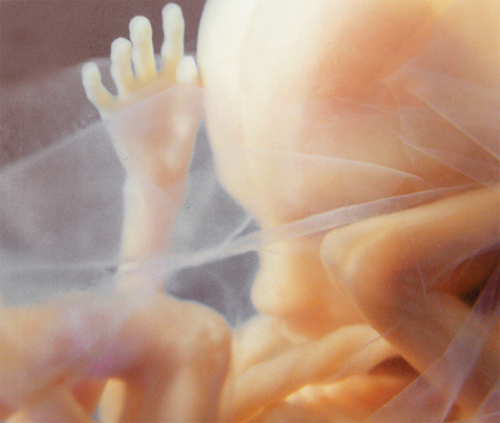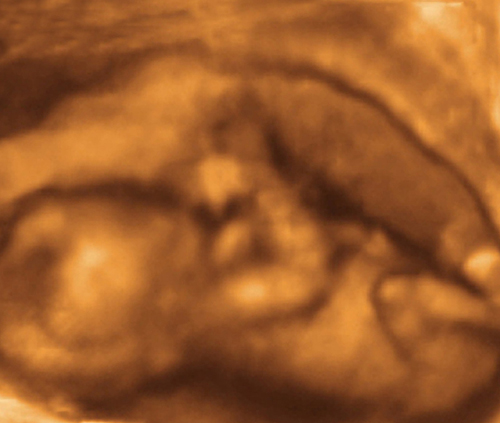You are 15 Weeks and 5 Days 170 days to go…
Your doctor may speak to you about writing a birth plan so she can get an idea of the type of labor and birth you want.
Your baby today
Here the baby is seen within the amniotic sac. For the first
time, her head is smaller than her body, marking another developmental
milestone. Having a large, heavy head is not a problem in the nearly
weightless environment of the uterus.

The purpose of a birth plan
is to communicate your wishes for labor and birth to those who are
caring for you. Writing a plan will help you to address different
aspects of the labor, such as methods of pain relief and who you’d like
to attend the birth. It also gives you a chance to ask questions about
procedures such as induction and other types of medical intervention.
Filling in a plan is also a useful way for your birth partner to be made
aware of your wishes so that he or she can communicate these to the
doctor while you’re in labor.
Bear in mind that
circumstances may dictate that not all of your preferences are met, but
there’s more chance of you getting the labor and birth you want if
you’ve thought it through and written down your views. Being as informed
as possible about labor and your choices will help you to prepare in advance.
… Doctor
| Q: |
I have dry eyes and am finding it hard to wear my contact lenses. What can I do?
|
| A: |
During pregnancy, hormonal changes may cause your eyes to feel
dry, and you may experience burning, itching, and a feeling that there
is a foreign object under your eyelid. This is common in pregnancy. Dry
eyes can also occur after menopause, when there are similar hormonal
fluctuations.
The condition
appears to be caused by a change in the composition and quantity of
tears, leaving the eye dry and inadequately lubricated. The discomfort
can be remedied with “artificial tears” (see image),
available from an optician or pharmacist, and it usually disappears
once the baby is born. In the meantime, limit the time you wear your
lenses and wear your glasses more often, especially if you are looking
at a computer screen for long periods of time.
|

Your birth plan
Scented candles,
womb music, and beanbags… or serious pain relief from the first
contraction? Writing a birth plan is an opportunity for you to think
about how you’d like your labor and delivery to go. Discuss your birth
plan with your doctor and birth partner as early as this week, so you’re
all clear about your objectives .
Write everything down:
your birth partner(s), pain-relief preferences, whether you’d like an
active labor, and the environment you’d prefer to give birth in. You
might know you want to give birth in the hospital or at home, or in a
birth center, which offers a home-style setting with the backup of
medical technology.
Be specific:
for example, you might want to use a birthing pool to labor in or want
to give birth in an upright position. You might want minimal medical
intervention.
Be flexible: labor doesn’t always go according to plan and your baby’s safe delivery is the most important thing.
You are 15 Weeks and 6 Days 169 days to go…
To help your baby’s
lungs expand and develop in preparation for breathing, the chest wall
must be fully bathed in amniotic fluid.
Your baby today
The upper limbs are well differentiated into forearms, wrists,
hands, and fingers; these develop at a faster rate than the lower limbs,
a feature that continues even after the birth.

Your baby’s lungs
continue to branch and divide. The cells lining the airways constantly
produce fluid that leaves the lungs when your baby makes breathing
movements. The release of this fluid is regulated by the vocal cords
within the larynx.
In addition to fluid,
the lungs have glands that produce mucus. Cells with tiny hairlike
structures, known as cilia, have appeared that help move the mucus. This
production of mucus is important once the baby is born to prevent the
constant flow of air from drying the lining of the lungs, to trap dust
particles, and to act as a barrier to infection.
Because the gut is
still very immature, the gradual increase in amniotic fluid is due to
the relatively low frequency of fetal swallowing. By 37 weeks your baby
will be swallowing 1.75 pints (almost a liter), half of the total
amniotic fluid volume, each day.
In this close-up
the baby’s left arm and chest wall can be seen. Because the skin is
almost transparent the ribs are easy to see. They are very soft at this
stage and still predominantly made of cartilage.

… Relationships
Surprisingly sexy
You may be taken aback by a sudden increase in your libido.
Often, in the second trimester, women find that they feel far more
energetic and sexy. The increased blood flow to the pelvic area combined
with an increased lubrication of the vagina means that, in theory,
having sex can be better than ever.
High levels of
progesterone and estrogen make your breasts and vagina super sensitive
so expect to become more easily aroused during foreplay. You may also
find that you orgasm more quickly than usual. The uterus tightens when
you orgasm, so be prepared for this.
Your partner may be
delighted by this up-turn in events, as well as approving of a
beautiful rounded body to explore, but if he isn’t responding
positively, talk to him about how he’s feeling.